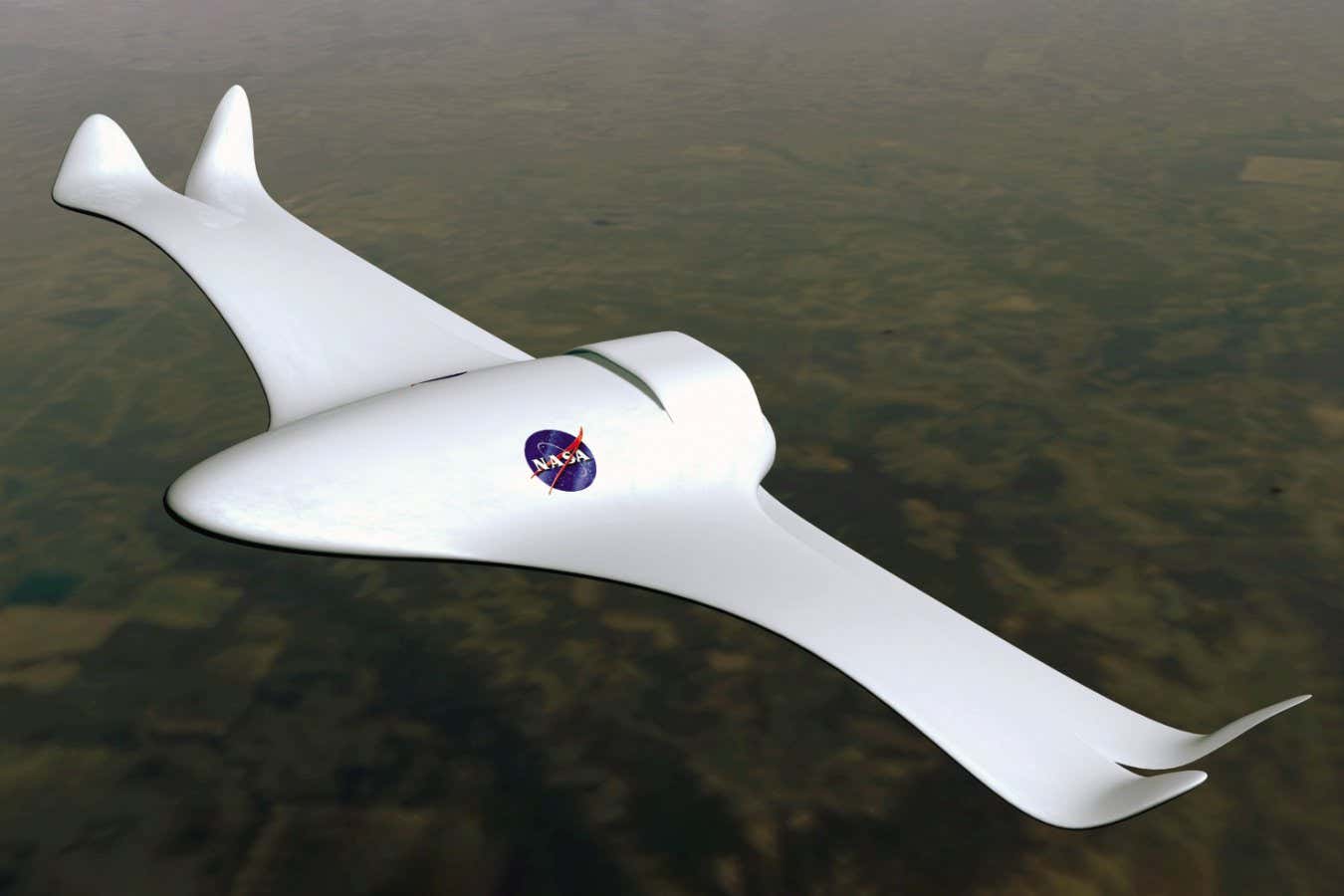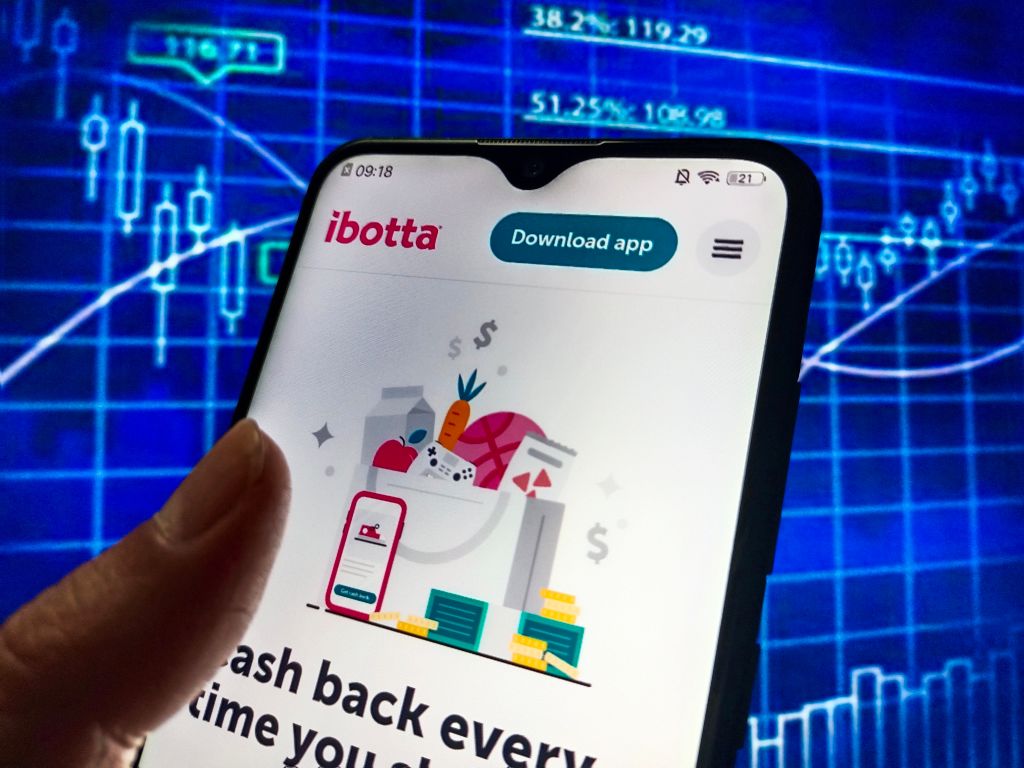Technology
Ultra-strong stretchy material could enable shape-shifting aircraft


An artist’s rendering of a futuristic aircraft with morphable wings
AFRL / NASA
An alloy of titanium and nickel is as strong as steel but stretches like a rubbery polymer. With some clever engineering, it may eventually lead to technologies like shape-shifting aircraft.
Imagine a plane with long wings that contract in midair to become shorter – and make the craft more aerodynamic – as it gains speed. To make this futuristic technology, engineers would need a material that is stretchy enough to change shape yet strong enough to withstand the elements during flight. Xiaobing Ren at the National Institute for…
Technology
Google Pixel Watch 3 vs. Pixel Watch: Is it upgrade time?
It’s been two years since Google burst into the smartwatch market, and that means we’ve seen a few upgrades since Google launched the very first Google Pixel Watch. If you’re still using that watch, you may wonder if now is the time to upgrade and whether the third-generation Pixel Watch 3 is worth it. Or you may be getting your first smartwatch and considering buying either a cheap first-generation Pixel Watch or the latest and greatest of Google’s wearables.
Choosing between these two devices is surprisingly easy. Sometimes, the newest is the best, and this is the case with the Pixel Watch 3. However, there’s a significant price difference, so is the Pixel Watch still worth buying? Let’s examine the differences to help determine which you should pick, and explain why now is the best time to upgrade from the original Pixel Watch.
Google Pixel Watch 3 vs. Google Pixel Watch: specs
| Google Pixel Watch 3 | Google Pixel Watch | |
| Display | 45mm: 1.4-inch
41mm: 1.2-inch Always-On Display Up to 1,000 nits |
1.2-inch
Always-On Display |
| Resolution and brightness | 45mm: 456 x 456 pixels (320 pixels per inch)
41mm: 408 x 408 pixels (~320 ppi density) |
450 x 450 pixels (320ppi)
Up to 1,000 nits |
| Dimensions and weight | 45mm: 45 x 45 x 12.3 mm (1.77 x 1.77 x 0.48 inches)
37 grams (without band) 41mm: 41 x 41 x 12.3 mm (1.61 x 1.61 x 0.48 inches) 31 grams (without band) |
41 x 41 x 12.3 mm (1.61 x 1.61 x 0.48 inches)
36 g (without band) |
| Processor | Qualcomm W5 Gen 1 | Samsung Exynos 9110 SoC |
| Storage & RAM | 32GB eMMC, 2GB RAM | 32GB eMMC, 2GB RAM |
| Battery | 45mm: 420mAh
41mm: 307mAh 2.5W charging using a dedicated USB-C to magnetic puck charger |
294mAh
2.5W charging using a dedicated USB-C to magnetic puck charger |
| Software | Wear OS 5.0 | Wear OS 3.5 |
| Sensors | Compass
Altimeter Red and infrared sensors for oxygen saturation (SpO2) monitoring Multipurpose electrical sensors compatible with the ECG app Multi-path optical heart rate sensor Accelerometer Gyroscope Ambient light sensor Electrical sensor to measure skin conductance (cEDA) for Body response tracking Skin temperature sensor Barometer Magnetometer |
Compass
Altimeter Blood oxygen saturation (SpO2) monitor Multipurpose electrical sensors compatible with the ECG app Optical heart rate sensor Accelerometer Gyroscope Ambient light sensor |
| Connectivity | 4G LTE (LTE models only) and UMTS
Bluetooth 5.0 Wi-Fi 802.11 b/g/n 2.4GHz NFC GPS GLONASS BeiDou Galileo Quasi-Zenith Satellite |
4G LTE (LTE models only) and UMTS
Bluetooth 5.0 Wi-Fi 802.11 b/g/n 2.4GHz NFC GPS GLONASS BeiDou Galileo |
| Materials and durability | 100% recycled aluminum shell
Soft-touch polymer Active band Gorilla Glass 5 over display IP68 rating (50 meters or 5ATM) |
80% recycled stainless steel shell
Soft-touch polymer Active band Gorilla Glass 5 over display IP68 rating (50 meters or 5ATM) |
| Colors | Matte black aluminum case, obsidian Active band
Polished silver aluminum case, porcelain Active band Matte hazel aluminum case, hazel Active band |
Matte black stainless steel case, Obsidian Active band
Polished silver stainless steel case, Charcoal Active band Polished silver stainless steel case, Chalk Active band Champagne gold stainless steel case, Hazel Active band |
| Price | From $349 | From $350 |
Google Pixel Watch 3 vs. Pixel Watch: design and display

Put the Pixel Watch 3 and Pixel Watch alongside each other, and aside from the size, it’s difficult to tell the difference. Google’s design language hasn’t changed a huge amount in three generations, and the minimalist look is attractive and works with most outfits.
The Pixel Watch 3 is the first of Google’s smartwatches to come in two sizes. The smaller 41mm size is identical to the original but 5 grams lighter, while the bigger 45mm version is just 1 gram heavier than the original. The larger size is ideal if you have bigger wrists or find the original Pixel Watch too small for daily use.
The new AMOLED-LTPO display gives the Pixel Watch 3 display a big upgrade over previous generations. Both sizes get the upgrade, which offers a variable refresh rate of 60Hz and shrunken bezels to maximize the screen real estate.

The display represents a significant upgrade in legibility, but otherwise, these two watches share the same physical traits. Domed Gorilla Glass displays provide protection, a rotating bezel allows you to scroll and select — a feature sorely missing from the new Samsung Galaxy Watch Ultra — and the same lug-style watch band system lets any Pixel Watch band work with the third-generation model.
Each watch has the same 5ATM water resistance, which provides protection when submerged up to 500 meters, and a suite of sensors on the rear. The Pixel Watch 3’s sensors are improved over the original’s, and they have a different design, but otherwise, these two watches share many similarities.
Google Pixel Watch 3 vs. Pixel Watch: health, fitness, sensors

The Pixel Watch 3 shares the same sensors as last year’s Pixel Watch 2, which saw Google improve the accuracy of the data collected. The heart rate sensor is one of the most accurate on any smartwatch and one of the many hardware sensors that are improved over the original.
The Pixel Watch 3 adds a thermometer and skin conductance sensors, which provide valuable insights into your skin temperature while asleep and are used for cycle tracking. There’s also a new light sensor, barometer, gyroscope, and the pulse oximeter used for the new Loss of Pulse Detection feature.

This feature is designed to get you help when you need it most. Most smartwatches offer a fall detection feature that will get you emergency help if you have a fall, but Loss of Pulse Detection takes things much further. If your Pixel Watch 3 fails to detect a pulse, it’ll undergo a further check to rule out a false negative and, failing that, contact emergency services. It’s only available in certain EU countries, but it’s a worthy reason to upgrade to the Pixel Watch 3.
The Pixel Watch 3 also adds new Cardio Load and Target Load features, a Daily Readiness score, and a Morning Briefing that gives you pertinent information on your health and sleep. The two Load features are designed to track your heart’s performance over the day (and longer) and give you a numerical understanding of your cardiac function. The Target Load feature then sets a daily goal to aspire to, ensuring you won’t overtrain or undertrain.

All of this information is presented in the Fitbit Premium app. Certain features, like the Daily Readiness score, required a Fitbit Premium subscription, but now all users get it included. The Pixel Watch 3 comes with six months of Fitbit Premium for free — just like the original — after which the subscription costs $10 per month or $80 per year.
Google Pixel Watch 3 vs. Pixel Watch: two versions of the same platform

The Pixel Watch 3 offers significantly more than the original, including hardware improvements and useful wellness features in Wear OS 5. Many of these are powered by Google AI, which analyzes and provides recommendations on achieving and surpassing your goals.
There are also unique features that only work when the Pixel Watch 3 is used alongside a Pixel phone. For example, if you have the Pixel 9 Pro or Pixel 9 Pro XL, you can use the Pixel Watch 3 to control the camera. You can also use it to control Google TV, letting you change volume, inputs, and virtually everything else from your watch.

You can also see your Nest Cam feed on the tiny screen and either respond using the microphone or send a canned response. Then, there are features like call screening and a smart recorder that can record and analyze audio using AI in real time. There are many Pixel Watch 3 features that will delight anyone who upgrades.
The original Pixel Watch is far more limited. It runs Wear OS 3.5 and offers a fairly standard introduction to the Pixel Watch experience. Many of the Pixel Watch 3 improvements launched on the Pixel Watch 2, and while some of these may eventually come to the original, some will likely remain exclusive to Google’s newer models.
Google Pixel Watch 3 vs. Pixel Watch: battery and charging

One of our biggest complaints about the first Pixel Watch was its battery life. Simply put, it’s not very good and requires recharging more than once per day. The Pixel Watch 3 solves these problems with a more efficient chipset, a larger battery, and improvements in the operating system.
The Pixel Watch has a 294mAh battery, while the Pixel Watch 3 has a larger 307mAh battery in the 41mm model and a 420mAh battery in the 45mm. The Exynos 9110 processor in the Pixel Watch offers far less efficiency than the Snapdragon SW5100 powering the Pixel Watch 3.
Our Pixel Watch 3 review found that the battery life on Google’s latest smartwatch is exceptional and routinely exceeds Google’s own estimates. That’s with the always-on display enabled, tracking multiple workouts and sleep overnight, and receiving notifications throughout the day when paired with the Pixel 9 Pro. Simply put, the battery life has been very impressive and is one of the best reasons to upgrade from the original.

This means you can expect all-day battery life of around 24 hours with the Always On display turned on or up to 36 hours with the Battery Saver mode enabled. Both are large improvements over the original Pixel Watch, which requires recharging to last a full day.
The Pixel Watch 3 is also vastly improved when it comes to charging. The 41mm is rated as recharging to 50% in just 24 minutes and reaching 85% in 35 minutes, while the 45mm is slightly slower at 28 minutes and 50 minutes, respectively. We found that it charges from 12% to 62% in 30 minutes, and a full charge takes just over an hour, but the fast charging is great for those days when you’ve been using it heavily.
Google Pixel Watch 3 vs. Pixel Watch: price, availability, colors

The Pixel Watch 3 is available now with a starting price of $349, while the original Pixel Watch launched at a similar price and is now available for just under $200. The price difference is significant, but the Pixel Watch 3 represents much better value despite the higher price.
If you want the Pixel Watch 3 in the 41mm size, the Bluetooth-only model is $349, while the LTE version is $449. For the larger size, add $50 to both of those prices.
The Pixel Watch 3 comes in a choice of colors. If you buy the 41mm model, you can choose from Polished Silver, Matte Black, or Champagne Gold, while the larger model ditches the gold option in favor of a more neutral Hazel color. There is a choice of bands, including a striking new Rose Quartz option that matches the colors of Google’s latest phones.
Google Pixel Watch 3 vs. Pixel Watch: verdict

If you have the original Pixel Watch, there’s never been a better time to upgrade. The Pixel Watch 3 offers everything you need from a smartwatch and is one of the most stylish options on our best smartwatch list. Crucially, it also adds features that will make your life easier and potentially even save it one day. If you’re considering which to buy and don’t currently have a Pixel Watch, it’s worth first looking at the Pixel Watch 3.
It is Google’s best smartwatch, but it costs double the original. If budget is a concern, the first Pixel Watch is a decent choice, but keep in mind that there are other smartwatches from the same era that are much better, like the Samsung Galaxy Watch 5. If you’d rather stay with Google, then we’d recommend buying the Pixel Watch 2, which is just $70 more, but a much better smartwatch.
However, if you can stretch your budget or snag a good deal, our Pixel Watch 3 review found that it’s the Google smartwatch we have been waiting for. It’s the best that Google offers and one of the best smartwatches you can buy in 2024. The original Pixel Watch still has some value, but given the vast improvements in the third generation, there’s no doubt that the Pixel Watch 3 is the better one to buy.
Science & Environment
Meet the world's first female male model | 7.30

Casey Legler is 6’2″, a gay activist, swam for France in the Olympic Games, and has become internationally acclaimed as the world’s first female male model. She spoke to Monique Schafter after completing an artist’s residency in Sydney. Read more here: http://ab.co/1GuC6Qs
For more from ABC News, click here: https://ab.co/2kd3ALi
You can watch more ABC News content ad-free on iview: https://ab.co/39iq2Xt
Subscribe to ABC News In-depth: https://www.youtube.com/c/abcnewsindepth
For breaking and trending news, subscribe to ABC News on YouTube: http://ab.co/1svxLVE
You can also like us on Facebook: http://facebook.com/abcnews.au
Or follow us on Instagram: http://instagram.com/abcnews_au
Or even on Twitter: http://twitter.com/abcnews
Technology
Nintendo files lawsuit against Palworld developer Pocketpair

Palworld was once one of gaming’s biggest hits thanks to its blend of Pokémon-like gameplay elements mixed with survival and crafting mechanics, but it was perhaps only a matter of time before Nintendo and The Pokémon Company filed a lawsuit against the game’s developers. That’s exactly what’s happening as Nintendo officially announced that together with The Pokémon Company it’s filing a lawsuit against Pocketpair.
Palworld saw huge success following its early access launch having sold nearly 5 million copies in just a few days. And it’s this kind of success that seems to have drawn Nintendo’s ire. The possibility of a lawsuit was looming well before now. However, it was also suspected that Nintendo may just let the whole thing go. After all, the game launched in January and it’s been 9 months. Pocketpair at one point also said that it had the game put through a few legal reviews and no issues were found.
But Nintendo seems to have found something, as its lawsuit states that Pocketpair is infringing on multiple patents. This lawsuit also shouldn’t come as a huge surprise, as The Pokémon Company confirmed back in January that it intended to investigate Palworld.
The Nintendo lawsuit against Palworld deve Pocketpair doesn’t mention specifics
While Nintendo has confirmed it’s filing a lawsuit against Pocketpair, the statement about the lawsuit doesn’t mention any specific details. As of right now, Nintendo isn’t saying what patents Pocketpair is infringing. However, it’s likely that information will come out in due time. Provided this lawsuit goes to court and the case proceeds.
So far the only thing Nintendo has said is that its lawsuit is seeking an injunction against Pocketpair for these infringements. However, no information is given in terms of what it’s actually seeking as an end result. “Nintendo Co., Ltd. (HQ: Kyoto, Minami-ku, Japan; Representative Director and President: Shuntaro Furukawa, “Nintendo” hereafter), together with The Pokémon Company, filed a patent infringement lawsuit in the Tokyo District Court against Pocketpair, Inc. (HQ: 2-10-2 Higashigotanda, Shinagawa-ku, Tokyo, “Defendant” hereafter) on September 18, 2024.
This lawsuit seeks an injunction against infringement and compensation for damages on the grounds that Palworld, a game developed and released by the Defendant, infringes multiple patent rights. Nintendo will continue to take necessary actions against any infringement of its intellectual property rights including the Nintendo brand itself, to protect the intellectual properties it has worked hard to establish over the years,” the statement reads.
Pocketpair has responded to the lawsuit
Following Nintendo’s statement, Pocketpair has issued its own statement in response to the lawsuit. Stating that at this time, it’s “unaware of the specific patents” that it’s accused of infringing. The developer also says that it “hasn’t been notified of such details.”
Pocketpair is a small indie dev based in Tokyo, Japan. So it’s likely an easy target for Nintendo given the size of the studio and the success of its game. Pocketpair says it will do everything it can to ensure that indie devs are not hindered or discouraged from pursuing their creative ideas. This might suggest that Pocketpair fully intends to fight this lawsuit. As it believes it hasn’t infringed on any of Nintendo or The Pokémon Company’s patents.
Palworld was launched on January 19, 2024, and was made available to play via GeForce NOW back on May 16.
Technology
Here’s what a TV show based on Untitled Goose Game could have been like

Cast your mind back to 2019, when by the idea of terrorizing a quaint English village as a loud, annoying goose. , but it was fairly short and left me wanting more. In another universe, a TV adaptation would have happened already. While that didn’t quite pan out here, we do have a funny proof-of-concept to enjoy.
House House, the game’s developer, a “proof-of-concept for a hypothetical Untitled Goose Programme” on its YouTube channel on Friday. The studio created the short with Playdate maker and Untitled Goose Game publisher Panic and animation house Chromosphere Studio. It’s a great four-minute clip that’s well worth your time. It shows a goose bullying a journalist and groundskeeper during a TV interview. The art style is lovely, the Wallace and Gromit-esque humor is on point and the goose is just as much of a jerk as the one in the game.
Sadly, House House says that the show didn’t gain traction and those involved put the idea on the shelf. But at least we get this very amusing video out of it. If nothing else, it reminded me that I need to play the Panic-published , which seems
Science & Environment
North Korea: Women’s football’s sleeping giant

“Normally when there are 30 shots in the game, it is the United States with about 25 of ’em. Not today!”
It wasn’t just the ESPN commentator who was shocked.
Heather O’Reilly had scored the game’s final goal, dragging world number ones and two-time champions United States to a 2-2 draw in their opening match at the 2007 Women’s World Cup.
O’Reilly wasn’t surprised by the scoreline though. Or how evenly-fought the game was. She knew it would be tough.
Instead, as the final whistle blew, it was the attitude of the US’s opponents, who saw a chance missed, rather than a point gained, that struck her.
“I remember North Korea seeming disappointed,” says O’Reilly.
“Their body language seemed to say ‘oh my gosh, we were so close to taking down the giant’.”
North Korea is the world’s most isolated country, a state based around the infallibility of Supreme Leader Kim Jong-un and a deep suspicion of the outside world.
Yet, despite living standards being well behind most other nations, North Korea has been one of the strongest female football nations on the planet.
When they took on the United States in 2007, they were ranked fifth in the world and amid a run of three Asian titles in the space of a decade.
Their record at youth level is even better. In 2016, they won the U20 Women’s World Cup, defeating Spain, the United States and France in the knockout rounds. That same year, their under-17 team also lifted their age-grade World Cup.
“The game in 2007 was challenging, really super hard,” remembers O’Reilly of her meeting with North Korea’s senior side. “It was hard to get the ball off them, they were buzzing around, very quick.”
There was another challenge though, one that was unique to North Korea.
“It was just such a cloud of uncertainty,” says O’Reilly. “The film we had on them was very limited, even by the standard of the times.
“Every time we played North Korea, it was always a mystery.”
The mystery now is, after a doping controversy and a four-year absence from international football, can North Korea’s women be a force once again?
Technology
Ibotta’s CEO explains why startups shouldn’t try to time the IPO market

The IPO market has not roared back in 2024 as many investors hoped it would — not yet, at least. Elevated interest rates (this week’s 50 bps rate cut notwithstanding) and uncertainty related to the U.S. election have prompted many companies to stay private and wait for better market conditions.
But a handful of companies did go public this spring. Enterprise rewards platform Ibotta, which builds the backend rewards program infrastructure for enterprise clients like Walmart and Exxon, was one of them, debuting on the NYSE on April 18. Its IPO priced above its initial price range at $88 a share and debuted at $117 a share. It’s currently trading at $63 a share with a $1.7 billion market cap.
Ibotta’s CEO, Bryan Leach, told TechCrunch that five months after the IPO, he doesn’t regret taking his company public this year. Going public requires months of planning, and he thinks companies trying to time the market are making a “huge mistake.”
“Who knows what the [Federal Reserve] will do?” Leach said. “[Bankers say] it’s always better to wait, but you never know what will happen when you wait. At the end of the day, it’s not a destination, it’s a phase.”
Numerous companies that were expected to go public in 2022 or 2023 are still waiting on the sidelines. Many of these companies are sitting on large valuations that they gained from funding rounds during the boom days of 2021 and they would have to suffer a haircut to go public. There were 310 IPOs in the U.S. in 2021, according to PitchBook data. This has dropped sharply since. There were 80 in 2022, 85 in 2023 and 37 through the first half of 2024.
Leach admitted that some people consider the fact that Ibotta’s stock has dropped nearly 50% since its IPO as a sign that going public at this time wasn’t the right decision, or they might say that the company should have waited. Still, he feels it is too early to draw such conclusions, pointing to how Instacart’s stock is now trading close to its debut price — it hit a 52-week high today — a year after its IPO.
“Things are going great,” Leach said. “We are the largest tech IPO in Colorado history. The stock has gone way up, and gone down, and that sort of settles in over the course of the year. From a company perspective, we’ve been pleasantly surprised by how much value we got out of being a public company.”
Public companies also have an air of legitimacy around them, and Leach said that leverage is useful when it comes to nabbing potential enterprise customers. He said the company’s recent deal with Instacart may not have happened if Ibotta were still private.
“They trust us,” Leach said. “We have a certain amount of legitimacy. They know we have the resources. They can look at our finances. They can see we don’t have any debt. There is a level of comfort that [being a public company] provides.”
He added that the same level of legitimacy applies to hiring, too. Ibotta is no longer offering stock options tied to a private valuation given by investors with no downside protection, and Leach said that makes the company a more attractive option for talent.
Leach said companies on the fence about doing an IPO shouldn’t try to time the market, but they should wait until they are ready to be a public company.
Going public this April was not the company’s first choice, either. During the SPAC and IPO craze of 2020 and 2021, Ibotta’s investors began asking it to go public, and so the company hired bankers and wrote up an S-1, an SEC document that kicks off the IPO process. It was ready to set out on an IPO roadshow in fall of 2021 but decided to hold off.
Ibotta had landed a large deal with Walmart to run a white-label version of its rewards program at the time, Leach said, but he wanted to be able to prove the deal was actually working before going public. Not everyone was pleased with the company’s decision to wait.
Still, Leach feels it was the right choice. Waiting until 2024 allowed Ibotta to go public with six quarters of profitability behind it and get its finances in order. Other late-stage companies in the same boat, he thinks, shouldn’t wait around for a “better” market.
Investors don’t seem to mind companies waiting it out — at least they aren’t expressing otherwise publicly. But the IPO market is bound to open again eventually. Interest rates have started to go down and there is an increase in rumors surrounding companies hiring bankers to start the IPO process. Companies may be done waiting come 2025.
-

 News4 days ago
News4 days agoYou’re a Hypocrite, And So Am I
-

 Sport3 days ago
Sport3 days agoJoshua vs Dubois: Chris Eubank Jr says ‘AJ’ could beat Tyson Fury and any other heavyweight in the world
-

 CryptoCurrency3 days ago
CryptoCurrency3 days agoEthereum is a 'contrarian bet' into 2025, says Bitwise exec
-

 Technology4 days ago
Technology4 days agoWould-be reality TV contestants ‘not looking real’
-

 Science & Environment4 days ago
Science & Environment4 days agoHow to unsnarl a tangle of threads, according to physics
-

 CryptoCurrency3 days ago
CryptoCurrency3 days agoDorsey’s ‘marketplace of algorithms’ could fix social media… so why hasn’t it?
-

 CryptoCurrency3 days ago
CryptoCurrency3 days agoDZ Bank partners with Boerse Stuttgart for crypto trading
-

 CryptoCurrency3 days ago
CryptoCurrency3 days agoLow users, sex predators kill Korean metaverses, 3AC sues Terra: Asia Express
-

 News4 hours ago
News4 hours agoOur millionaire neighbour blocks us from using public footpath & screams at us in street.. it’s like living in a WARZONE – WordupNews
-

 Science & Environment3 days ago
Science & Environment3 days ago‘Running of the bulls’ festival crowds move like charged particles
-

 News3 days ago
News3 days agoIsrael strikes Lebanese targets as Hizbollah chief warns of ‘red lines’ crossed
-

 CryptoCurrency3 days ago
CryptoCurrency3 days agoBitcoin miners steamrolled after electricity thefts, exchange ‘closure’ scam: Asia Express
-

 CryptoCurrency3 days ago
CryptoCurrency3 days agoRedStone integrates first oracle price feeds on TON blockchain
-

 CryptoCurrency3 days ago
CryptoCurrency3 days agoBitcoin bulls target $64K BTC price hurdle as US stocks eye new record
-

 CryptoCurrency3 days ago
CryptoCurrency3 days agoVitalik tells Ethereum L2s ‘Stage 1 or GTFO’ — Who makes the cut?
-

 CryptoCurrency3 days ago
CryptoCurrency3 days agoBlockdaemon mulls 2026 IPO: Report
-

 Science & Environment3 days ago
Science & Environment3 days agoQuantum ‘supersolid’ matter stirred using magnets
-

 Sport3 days ago
Sport3 days agoUFC Edmonton fight card revealed, including Brandon Moreno vs. Amir Albazi headliner
-

 Science & Environment3 days ago
Science & Environment3 days agoHyperelastic gel is one of the stretchiest materials known to science
-

 Science & Environment3 days ago
Science & Environment3 days agoQuantum forces used to automatically assemble tiny device
-

 Health & fitness4 days ago
Health & fitness4 days agoThe secret to a six pack – and how to keep your washboard abs in 2022
-

 CryptoCurrency3 days ago
CryptoCurrency3 days agoCardano founder to meet Argentina president Javier Milei
-

 CryptoCurrency3 days ago
CryptoCurrency3 days agoCertiK Ventures discloses $45M investment plan to boost Web3
-

 CryptoCurrency3 days ago
CryptoCurrency3 days agoVonMises bought 60 CryptoPunks in a month before the price spiked: NFT Collector
-

 CryptoCurrency3 days ago
CryptoCurrency3 days agoSEC asks court for four months to produce documents for Coinbase
-

 CryptoCurrency3 days ago
CryptoCurrency3 days ago‘Silly’ to shade Ethereum, the ‘Microsoft of blockchains’ — Bitwise exec
-

 CryptoCurrency3 days ago
CryptoCurrency3 days ago‘No matter how bad it gets, there’s a lot going on with NFTs’: 24 Hours of Art, NFT Creator
-

 CryptoCurrency3 days ago
CryptoCurrency3 days agoCoinbase’s cbBTC surges to third-largest wrapped BTC token in just one week
-

 Technology3 days ago
Technology3 days agoiPhone 15 Pro Max Camera Review: Depth and Reach
-

 Science & Environment3 days ago
Science & Environment3 days agoHow one theory ties together everything we know about the universe
-

 Science & Environment3 days ago
Science & Environment3 days agoSunlight-trapping device can generate temperatures over 1000°C
-

 News3 days ago
News3 days agoBrian Tyree Henry on voicing young Megatron, his love for villain roles
-

 Science & Environment4 days ago
Science & Environment4 days agoTime travel sci-fi novel is a rip-roaringly good thought experiment
-

 Science & Environment4 days ago
Science & Environment4 days agoLaser helps turn an electron into a coil of mass and charge
-

 Science & Environment4 days ago
Science & Environment4 days agoITER: Is the world’s biggest fusion experiment dead after new delay to 2035?
-

 Science & Environment4 days ago
Science & Environment4 days agoLiquid crystals could improve quantum communication devices
-

 Science & Environment4 days ago
Science & Environment4 days agoHow to wrap your mind around the real multiverse
-

 Science & Environment3 days ago
Science & Environment3 days agoPhysicists are grappling with their own reproducibility crisis
-

 Science & Environment3 days ago
Science & Environment3 days agoNuclear fusion experiment overcomes two key operating hurdles
-

 CryptoCurrency3 days ago
CryptoCurrency3 days ago$12.1M fraud suspect with ‘new face’ arrested, crypto scam boiler rooms busted: Asia Express
-

 CryptoCurrency3 days ago
CryptoCurrency3 days agoEthereum falls to new 42-month low vs. Bitcoin — Bottom or more pain ahead?
-

 CryptoCurrency3 days ago
CryptoCurrency3 days agoETH falls 6% amid Trump assassination attempt, looming rate cuts, ‘FUD’ wave
-

 CryptoCurrency3 days ago
CryptoCurrency3 days agoBitcoin options markets reduce risk hedges — Are new range highs in sight?
-

 News3 days ago
News3 days agoChurch same-sex split affecting bishop appointments
-

 Politics5 days ago
Politics5 days agoTrump says he will meet with Indian Prime Minister Narendra Modi next week
-

 Science & Environment4 days ago
Science & Environment4 days agoWhy this is a golden age for life to thrive across the universe
-

 Technology5 days ago
Technology5 days agoCan technology fix the ‘broken’ concert ticketing system?
-

 Politics3 days ago
Politics3 days agoLabour MP urges UK government to nationalise Grangemouth refinery
-

 Science & Environment4 days ago
Science & Environment4 days agoMaxwell’s demon charges quantum batteries inside of a quantum computer
-

 Science & Environment4 days ago
Science & Environment4 days agoQuantum time travel: The experiment to ‘send a particle into the past’
-

 CryptoCurrency3 days ago
CryptoCurrency3 days ago2 auditors miss $27M Penpie flaw, Pythia’s ‘claim rewards’ bug: Crypto-Sec
-

 CryptoCurrency3 days ago
CryptoCurrency3 days agoHelp! My parents are addicted to Pi Network crypto tapper
-

 CryptoCurrency3 days ago
CryptoCurrency3 days agoCrypto scammers orchestrate massive hack on X but barely made $8K
-

 Science & Environment3 days ago
Science & Environment3 days agoWhy we need to invoke philosophy to judge bizarre concepts in science
-

 CryptoCurrency3 days ago
CryptoCurrency3 days agoSEC sues ‘fake’ crypto exchanges in first action on pig butchering scams
-

 CryptoCurrency3 days ago
CryptoCurrency3 days agoBitcoin price hits $62.6K as Fed 'crisis' move sparks US stocks warning
-

 CryptoCurrency3 days ago
CryptoCurrency3 days agoCZ and Binance face new lawsuit, RFK Jr suspends campaign, and more: Hodler’s Digest Aug. 18 – 24
-

 CryptoCurrency3 days ago
CryptoCurrency3 days agoBeat crypto airdrop bots, Illuvium’s new features coming, PGA Tour Rise: Web3 Gamer
-

 CryptoCurrency3 days ago
CryptoCurrency3 days agoMemecoins not the ‘right move’ for celebs, but DApps might be — Skale Labs CMO
-

 CryptoCurrency3 days ago
CryptoCurrency3 days agoTelegram bot Banana Gun’s users drained of over $1.9M
-
Politics3 days ago
The Guardian view on 10 Downing Street: Labour risks losing the plot | Editorial
-

 Politics3 days ago
Politics3 days agoI’m in control, says Keir Starmer after Sue Gray pay leaks
-
Business3 days ago
How Labour donor’s largesse tarnished government’s squeaky clean image
-
Politics3 days ago
‘Appalling’ rows over Sue Gray must stop, senior ministers say | Sue Gray
-
Business3 days ago
UK hospitals with potentially dangerous concrete to be redeveloped
-

 News3 days ago
News3 days agoSean “Diddy” Combs denied bail again in federal sex trafficking case
-

 Technology3 days ago
Technology3 days agoFivetran targets data security by adding Hybrid Deployment
-
Politics5 days ago
Starmer ally Hollie Ridley appointed as Labour general secretary | Labour
-

 Money4 days ago
Money4 days agoWhat estate agents get up to in your home – and how they’re being caught
-

 Business5 days ago
Business5 days agoGuardian in talks to sell world’s oldest Sunday paper
-
News3 days ago
Freed Between the Lines: Banned Books Week
-

 MMA3 days ago
MMA3 days agoUFC’s Cory Sandhagen says Deiveson Figueiredo turned down fight offer
-

 MMA3 days ago
MMA3 days agoDiego Lopes declines Movsar Evloev’s request to step in at UFC 307
-

 Football3 days ago
Football3 days agoSlot's midfield tweak key to Liverpool victory in Milan
-

 Science & Environment3 days ago
Science & Environment3 days agoHow to wrap your head around the most mind-bending theories of reality
-

 Fashion Models3 days ago
Fashion Models3 days agoMiranda Kerr nude
-

 Fashion Models3 days ago
Fashion Models3 days ago“Playmate of the Year” magazine covers of Playboy from 1971–1980
-

 News6 days ago
News6 days agoDid the Pandemic Break Our Brains?
-

 Politics5 days ago
Politics5 days agoTrump Media breached ARC Global share agreement, judge rules
-

 Science & Environment3 days ago
Science & Environment3 days agoA new kind of experiment at the Large Hadron Collider could unravel quantum reality
-

 Fashion Models3 days ago
Fashion Models3 days agoMixte
-

 Science & Environment3 days ago
Science & Environment3 days agoHow Peter Higgs revealed the forces that hold the universe together
-

 Science & Environment3 days ago
Science & Environment3 days agoOdd quantum property may let us chill things closer to absolute zero
-

 Science & Environment3 days ago
Science & Environment3 days agoRethinking space and time could let us do away with dark matter
-

 Entertainment3 days ago
Entertainment3 days ago“Jimmy Carter 100” concert celebrates former president’s 100th birthday
-

 News4 days ago
News4 days ago▶️ Media Bias: How They Spin Attack on Hezbollah and Ignore the Reality
-

 News4 days ago
News4 days agoRoad rage suspects in custody after gunshots, drivers ramming vehicles near Boise
-

 Science & Environment4 days ago
Science & Environment4 days agoNerve fibres in the brain could generate quantum entanglement
-
Business5 days ago
Glasgow to host scaled-back Commonwealth Games in 2026
-

 Science & Environment4 days ago
Science & Environment4 days agoX-ray laser fires most powerful pulse ever recorded
-

 Science & Environment3 days ago
Science & Environment3 days agoBeing in two places at once could make a quantum battery charge faster
-

 Health & fitness5 days ago
Health & fitness5 days agoWhat ‘elite sleepers’ can tell us all about the eight hour myth
-

 Science & Environment3 days ago
Science & Environment3 days agoWe may have spotted a parallel universe going backwards in time
-

 CryptoCurrency3 days ago
CryptoCurrency3 days agoTreason in Taiwan paid in Tether, East’s crypto exchange resurgence: Asia Express
-

 CryptoCurrency3 days ago
CryptoCurrency3 days agoJourneys: Robby Yung on Animoca’s Web3 investments, TON and the Mocaverse
-

 CryptoCurrency3 days ago
CryptoCurrency3 days agoLouisiana takes first crypto payment over Bitcoin Lightning
-

 CryptoCurrency3 days ago
CryptoCurrency3 days agoAre there ‘too many’ blockchains for gaming? Sui’s randomness feature: Web3 Gamer
-

 CryptoCurrency3 days ago
CryptoCurrency3 days ago‘Everything feels like it’s going to shit’: Peter McCormack reveals new podcast
-

 Science & Environment3 days ago
Science & Environment3 days agoA single atom could drive a piston in a quantum engine
-

 Science & Environment3 days ago
Science & Environment3 days agoTiny magnet could help measure gravity on the quantum scale

You must be logged in to post a comment Login